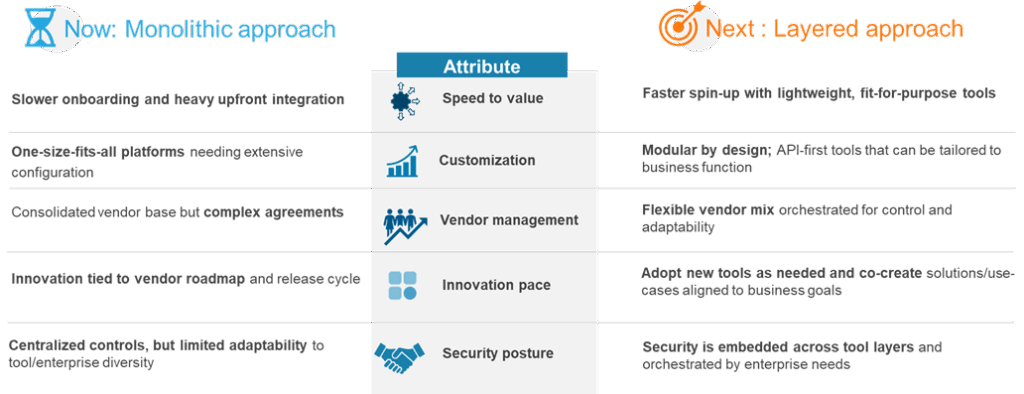
“Control is no longer about owning the stack – it’s about orchestrating it on your terms.” Enterprises are done with oversized, monolithic tech stacks. Mid-market firms are leading the charge toward modular, fit-for-purpose tools that are easier to deploy, cheaper to run, and built for agility. Read on to find out how the workplace stack is being democratized, or get in touch.
Monolithic stack fatigue is real
Much like billable hours in consulting or perimeter firewalls in cybersecurity, the idea of a singular, monolithic workplace tech stack is losing relevance. From IT Service Management (ITSM) to collaboration to employee experience, enterprises are increasingly questioning one-vendor suites in favor of fit-for-purpose workplace ecosystems. This isn’t vendor churn; it’s a tech stack rebellion. For instance, mid-market enterprises are rejecting heavyweight enterprise solutions in favor of platforms such as Freshworks, Zoom, Zoho, GoTo and other tools including open source platforms for productivity, collaboration, and agility.
The appeal is clear: simpler deployment, innovative pricing, and flexible functionality. As Freshworks CEO Dennis Woodside noted, many mid-market companies are “tired of being forced into oversized solutions that are hard to implement and operate”. As per some industry estimates, Zoom now holds over 55% of the global video conferencing market, reflecting how user-friendly, modular tools are becoming mainstream.
What’s driving this shift?
Multiple forces are catalyzing this diversification of the workplace tech stack.

These forces are evident in recent enterprise behavior. For instance, companies wasted an average of US$18 million on unused SaaS licenses in 2023, a 7% increase from the prior year. Not surprisingly, seven in ten firms now cite SaaS license rationalization as a top priority, as CFOs clamp down on software bloat.
Similarly, geopolitics is reshaping enterprise workplace tech stack decisions: German state of Schleswig-Holstein is currently in the process of phasing out Microsoft products such as Office 365 and Windows in favor of open-source solutions such as LibreOffice and Linux. Denmark’s Ministry for Digitalization is piloting a similar scheme.
Architectural responses: Lock-in to layered tech stack
As enterprise priorities are shifted by cost scrutiny, regulatory pressure, and the need for modularity, the response is increasingly architectural. It’s not just about switching vendors or trimming licenses. Enterprises are fundamentally rethinking how they assemble their digital workplace environments. Below are three key architectural responses we see gaining momentum:
- Composable micro-stacks by function: Instead of buying into a single vendor’s suite, organizations are assembling micro-stacks tailored to specific functions. For example, a company may leverage Freshworks for ITSM, Microsoft SharePoint for collaboration, and Zoom for communication, interconnected via APIs and workflow engines. This approach allows teams and function heads to update or swap components without overhauling the entire stack.
- Open-core platforms and developer-led tools: Tech teams are reclaiming control of tooling decisions.Platforms that support extensibility, such as GitHub Copilot, Kubernetes, and other open-source analytics frameworks, are replacing closed, monolithic solutions. In 2024, 95% of enterprises maintained or increased open-source use, prioritizing flexibility, speed, and transparency over lock-in. This developer-first mindset is reshaping tech stacks from the ground up.
- Distributed cloud strategy: Workplace workloads now span public, private, and sovereign clouds. Sensitive HR or compliance-critical data may stay in enterprise data centers, while collaboration runs on Google Workspace or Azure. Tools like Nexthink and Lakeside deliver cloud-native telemetry and experience monitoring across these hybrid setups. This distributed architecture helps IT meet performance goals, localize data, and respond swiftly to regulatory shifts. Today, 85% of organizations use or plan to use multi-cloud strategies to avoid lock-in and adapt to regulatory demands.
Even tech giants are adapting to this shift. ServiceNow, long established as a heavyweight in enterprise IT, is now repositioning to serve the mid-market with more modular, low cost digital workplace offerings. The message is clear. Even market leaders must evolve with humility and agility to stay relevant in a landscape that now demands openness, interoperability, and user-centric design.
The new tech-stack philosophy
How does the traditional rigid tech stack compare to a modular, context-driven stack?

In essence, a traditional stack can simplify governance, but at the cost of agility, whereas a fragmented stack accelerates innovation at the cost of requiring mature management. Many enterprises are finding that the benefits outweigh the drawbacks if they invest in the right integration, talent, security, and governance. Modern API management, single sign-on, and observability tools, for example, can mitigate much of the complexity of a multi-tool environment. The goal is to get the best of both worlds: flexibility without compromising reliability.
As IT services move from labor-heavy delivery to agile, productized models, workplace tech ecosystems must evolve from static infrastructure to dynamic execution layers. Key questions for CIOs and CTOs to consider in the current scenario:
- Are we overpaying for features we don’t use?
- Can our tech choices flex with regulation and localization mandates?
- Is our stack “agentic”-ready?
- Is vendor diversification a risk or a strategic hedge?
In navigating these questions, leading IT organizations are powering up their integration and orchestration capabilities. The CIO’s role is expanding from technology manager to tech ecosystem architect.
The democratization of the tech stack
We are not witnessing the doom of the enterprise tech stack; we are witnessing its democratization. The stack is no longer locked into monolithic, one-size-fits-all platforms. Instead, it is opening, fragmenting into specialized, swappable components that can be chosen, combined, and reconfigured by those closest to the business’ needs. Users gain flexibility, business context drives design, and intelligent orchestration binds it all together.
In this new paradigm, success will not come from dominating the entire stack, but from enabling choice, interoperability, and agility. For providers and consumers alike, the message is clear: control in the next era comes not from owning every layer, but from empowering ecosystems to integrate seamlessly into a responsive, cohesive whole.
If you’re an enterprise, it’s time to rethink your workplace tech stack; if you’re a tech vendor, the challenge is to expand platform capabilities; and if you’re a service provider, the opportunity is to deliver greater client value.
Regardless of which category you belong to, we can help you in this journey toward an elevated workplace tech stack, please reach out to [email protected] or [email protected]. We would love to know your perspective. Share your objectives for the workplace tech stack by filling out the form: https://forms.office.com/r/0TmiGBDDLc. Alternatively, read about enabling AI-ready enterprises with a redefined tech stack.









